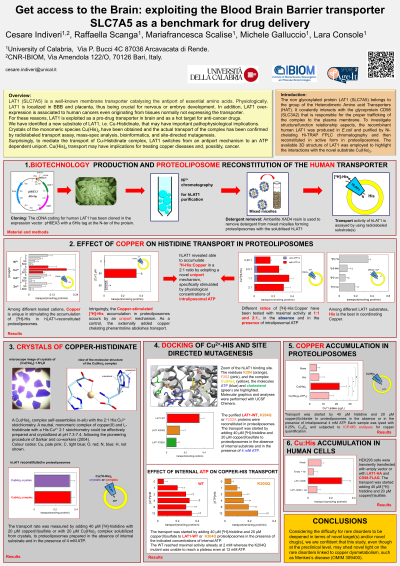Screening Applications & Diagnostics
Poster Session B
(1049-B) Get access to the Brain: exploiting the Blood Brain Barrier transporter SLC7A5 as a benchmark for drug delivery.
Wednesday, May 29, 2024
10:30 - 11:15 CEST
Location: Exhibit Hall

.jpg)
Cesare Indiveri, Professor PhD (he/him/his)
Full Professor - Director
University of Calabria - CNR (IBIOM)
Bari, Puglia, Italy
Poster Presenter(s)
Abstract: SLC7A5 also known as LAT1 (belonging to the SoLute Carrier superfamily) is a transporter for essential amino acids mainly located in the Blood Brain Barrier and the Placenta Barrier under physiological conditions. Very interestingly, the same transporter is over-expressed in virtually all human cancers even those originating from tissues in which SLC7A5 is normally poorly expressed. Therefore, on the one hand, SLC7A5 is a potential vehicle for drug delivery to the brain and placenta, on the other hand, it is an ideal target for novel anti-cancer drugs.
The role of SLC7A5 in providing the brain with essential amino acids has been unequivocally demonstrated by a comprehensive study ranging from in vitro and in silico to in vivo experimental approaches. Indeed, some forms of autism spectrum disorders are triggered by mutation of LAT1 causing the impaired release of essential amino acids to the brain. The human mutations have been reproduced in recombinant proteins and the molecular basis of the altered transport has also been defined [1].
Very recently this transporter has been exploited for a novel therapeutic function, which is the ability to mediate the transport of copper in complex with the SLC7A5 substrate histidine, i.e., in the form of Cu2+-histidinate. Indeed, LAT1 can mediate a high-affinity transport of Cu2+-histidinate in the in vitro model of proteoliposomes and in the ex vivo model of HEK293 cells [2].
This novel transport function of SLC7A5 has more than one possible application. At first, it can be exploited for the cure of a rare genetic syndrome, called Menkes Disease, caused by the alteration of copper absorption in the brain. Indeed, an empirical use of similar complexes has already been attempted even without any information on the mechanism of action.
A broader and very impactful application is represented by the possibility of substituting platinum-based cancer therapies, which display severe side effects, with copper-based therapy in brain tumours [3]. Moreover, the over-expression of SLC7A5 in other human cancers opens the possibility of using this type of drug for human cancers other than the brain.
1 Tărlungeanu DC, …, Scalise M,… Indiveri C, …, Novarino G. Cell. 2016 doi: 10.1016/j.cell.2016.11.013.
2 Scanga R, Scalise M, …, Indiveri C. iScience. 2023 doi: 10.1016/j.isci.2023.107738.
3 Banerjee S, Banerjee S. Anticancer Agents Med Chem. 2022 doi:10.2174/1871520622666220331085144.
The role of SLC7A5 in providing the brain with essential amino acids has been unequivocally demonstrated by a comprehensive study ranging from in vitro and in silico to in vivo experimental approaches. Indeed, some forms of autism spectrum disorders are triggered by mutation of LAT1 causing the impaired release of essential amino acids to the brain. The human mutations have been reproduced in recombinant proteins and the molecular basis of the altered transport has also been defined [1].
Very recently this transporter has been exploited for a novel therapeutic function, which is the ability to mediate the transport of copper in complex with the SLC7A5 substrate histidine, i.e., in the form of Cu2+-histidinate. Indeed, LAT1 can mediate a high-affinity transport of Cu2+-histidinate in the in vitro model of proteoliposomes and in the ex vivo model of HEK293 cells [2].
This novel transport function of SLC7A5 has more than one possible application. At first, it can be exploited for the cure of a rare genetic syndrome, called Menkes Disease, caused by the alteration of copper absorption in the brain. Indeed, an empirical use of similar complexes has already been attempted even without any information on the mechanism of action.
A broader and very impactful application is represented by the possibility of substituting platinum-based cancer therapies, which display severe side effects, with copper-based therapy in brain tumours [3]. Moreover, the over-expression of SLC7A5 in other human cancers opens the possibility of using this type of drug for human cancers other than the brain.
1 Tărlungeanu DC, …, Scalise M,… Indiveri C, …, Novarino G. Cell. 2016 doi: 10.1016/j.cell.2016.11.013.
2 Scanga R, Scalise M, …, Indiveri C. iScience. 2023 doi: 10.1016/j.isci.2023.107738.
3 Banerjee S, Banerjee S. Anticancer Agents Med Chem. 2022 doi:10.2174/1871520622666220331085144.
